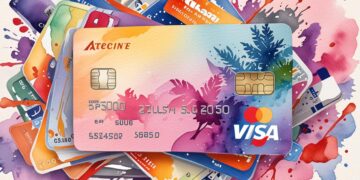Credit Cards for Students: Tips and Challenges in Financial Management

The Importance of Financial Literacy for Students
As students begin their academic adventures, the intricacies of managing finances can swiftly transform into a complex challenge. The landscape of education is populated with various expenses, from tuition fees and textbooks to looming living costs, prompting many to turn to credit cards. While these plastic companions can offer convenience and flexibility, the uncharted waters of credit can harbor traps for the inexperienced. Understanding both the advantages and disadvantages associated with credit cards is essential for students to make informed financial decisions.
Building Credit History
One significant benefit of using credit cards is that they help in building credit history. Establishing a good credit score early can play a pivotal role in a student’s future financial endeavors. For instance, when the time comes to secure a loan for a car or buy a home, lenders often assess an individual’s credit history. A solid track record of on-time payments can ease this process. Moreover, students who take advantage of student credit cards often find that these cards come with lower limits and manageable requirements, making them an ideal starting point for building credit responsibly.
Rewards Programs
Many student credit cards also offer attractive rewards programs tailored to their users. These can include cash back on essential purchases like groceries, gas, and even school supplies. For example, some Canadian credit card providers may offer up to 5% cash back on select categories, which can result in substantial savings if managed wisely. Embracing these perks allows students to maximize their spending power while maintaining financial health.
High-Interest Rates
However, a key consideration when utilizing credit cards is the potential for high-interest rates. New users should be acutely aware of what happens if they carry a balance. Paying off the total balance by the due date can help avoid accruing interest, yet if balances are left unpaid, the costs can accumulate rapidly. For instance, if a student charges $1,000 on a card with a 20% annual percentage rate (APR) and only pays the minimum, they could end up paying hundreds of dollars more over time. This highlights the importance of understanding the terms and conditions provided by credit card issuers, and it emphasizes the need for careful budgeting.
Financial Discipline
In addition to awareness of interest rates, students must develop financial discipline. Learning to create and stick to a budget is fundamental for avoiding debt traps. Utilizing tools such as mobile apps or spreadsheets can aid in tracking expenditures and ensuring payments are made on time. Engaging in workshops on financial literacy offered by universities or community organizations can expand their understanding of personal finance management.
Conclusion
While the allure of credit cards is tangible, the responsibility that comes with them requires thoughtful consideration. As students learn to navigate the maze of financial independence, they should leverage the benefits of credit while cultivating responsible habits. This balanced approach can serve as a stepping stone toward a secure financial future. By opening the door to credit cards and parental guidance, students can embark on a journey towards financial literacy that will empower them throughout their lives.
DON’T MISS OUT: Click here to learn how to apply effortlessly
Understanding the Basics of Credit Cards
For many students, embarking on the journey of financial independence coincides with the first experience of handling a credit card. However, before diving into credit applications, it is essential to grasp some fundamental concepts that define how credit cards operate. This understanding can act as a safe harbor amidst a sea of financial decisions.
Types of Credit Cards for Students
When it comes to credit cards specifically designed for students, there are a few prevalent options. Recognizing the differences between these card types can significantly impact a student’s financial strategy:
- Secured Credit Cards: These cards require a cash deposit that serves as collateral. They are beneficial for students looking to build credit but can make accessing credit limits somewhat limited based on the deposited amount.
- Unsecured Student Credit Cards: Unsecured cards do not require a deposit, offering a line of credit based on the applicant’s creditworthiness. While they may come with lower initial limits, responsible use can lead to credit limit increases.
- Rewards Credit Cards: Student credit cards often feature rewards programs that allow cardholders to earn points or cashback on purchases. These rewards can be particularly appealing for students who frequently spend on necessities.
As students evaluate which card aligns best with their financial goals, they should weigh factors such as interest rates, annual fees, and reward structures. Ultimately, the right card can become an invaluable tool in developing responsible credit habits.
Understanding Credit Limits
Another critical element of credit management is the concept of credit limits. This is the maximum amount a credit card holder can charge to their account. Typically, students receive lower credit limits, which can be beneficial for maintaining discipline. Students new to credit should aim to use only a small portion of their available credit—ideally under 30%—to positively influence their credit scores. For example, if a card has a $1,000 limit, keeping the balance under $300 can be a wise strategy to build credit history without overspending.
Paying Off Balances
The practice of paying off credit card balances in full each month cannot be overstated. This habit not only avoids interest charges but also builds a favorable credit history. Many financial advisors recommend setting up reminders or utilizing auto-pay features to ensure timely payments. Additionally, students should review their statements regularly to monitor spending patterns, detect any unauthorized transactions, and identify opportunities for savings.
To supplement their credit education, students should explore various online resources, tools, and forums dedicated to personal finance. Understanding the intricacies of credit cards and their implications lays the groundwork for a financially savvy future. As students transition into adulthood, the skills they develop today will undoubtedly ripple out into their broader financial strategies, shaping their economic experiences for years to come.
DISCOVER MORE: Click here for a step-by-step guide
Developing Financial Literacy as a Student
As students navigate the complexities of using credit cards, enhancing their financial literacy becomes paramount. This entails acquiring knowledge about budgeting, managing expenses, and understanding the implications of debt. Being financially literate empowers students to make informed decisions that can avert unnecessary financial stress.
Creating a Budget
One essential practice that can significantly ease financial management is creating a budget. This involves mapping out monthly income—often modest for students due to part-time jobs or internships—and expenses, including tuition, housing, food, and personal items. By categorizing their expenditures, students can better understand where their money is going and adjust their spending habits accordingly. A basic budgeting app or even a simple spreadsheet can go a long way in keeping financial goals within reach.
The Importance of Timely Payments
Failing to make timely payments is one of the biggest pitfalls for credit card holders. A late payment not only incurs additional fees but can also negatively impact a student’s credit score. In Canada, the minimum payment is often a percentage of the outstanding balance, and while it can be tempting to only pay the required amount, this strategy should be avoided. Instead, students should strive to pay off the entire balance before the due date each month. This practice not only helps in avoiding debt but also establishes a strong credit history, which is critical when applying for larger loans, such as car or mortgage loans, in the future.
Using Credit Responsibly
Students must understand the importance of responsible credit usage. One of the primary advantages of a credit card is building a credit history, which is invaluable when seeking financial products post-graduation. To cultivate a positive credit score, students should avoid maxing out their credit limits and refrain from applying for multiple cards simultaneously, as multiple inquiries can hurt credit scores. Instead, adopting a strategy of using one or two cards and managing them well can lay the groundwork for a solid credit profile.
Potential Pitfalls
While credit cards offer numerous benefits, they also come with potential challenges that students should remain vigilant about. Among these challenges is the risk of falling into a debt spiral. It can be easy to swipe a card in times of need or when tempted by instant gratification. However, this practice can lead to accumulating debt that’s challenging to repay, especially with the high-interest rates that many credit cards carry. Canadian students should be especially mindful of the economic climate, as certain trends can lead to increased cost of living, impacting their ability to repay debts.
In addition to debt challenges, students should also be aware of annual fees associated with credit cards. While some student cards come with no yearly fees, others may impose a charge that isn’t justified by the rewards or benefits offered. It’s crucial for students to research and compare options, ensuring they choose cards that align with their financial habits and goals.
Leveraging Credit Card Rewards
When used responsibly, many student credit cards come with enticing reward programs. These may include cashback on purchases or points redeemable for travel, merchandise, or experiences. Students who frequently shop for essentials or engage in regular dining out should take advantage of these programs, which can ultimately lead to saving money or gaining valuable perks. However, it’s always wise to analyze spending patterns to ensure that the pursuit of rewards does not lead to irresponsible spending.
As students invest time and effort into understanding and implementing these financial strategies, the groundwork for a stable financial future emerges. Through discipline and education, young adults can transform their credit card experience from a source of potential pitfalls to a pathway towards financial empowerment.
DIVE DEEPER: Click here to learn about sustainable investments
Final Reflections on Student Credit Card Management
In conclusion, navigating the world of credit cards as a student can be a balancing act between opportunity and responsibility. The challenge lies not only in understanding the intricacies of credit but also in managing one’s finances effectively. As students embrace their newfound independence, prioritizing financial literacy becomes essential. The skills learned today will resonate far into the future, affecting their ability to secure major loans, housing, and other critical financial products.
Creating a budget and maintaining a disciplined approach to spending are vital components of successful financial management. The key takeaway for students is the importance of timely payments and responsible credit usage. By paying off balances in full and avoiding unnecessary debt, students can build a strong credit history that serves as a foundation for future financial endeavors.
Though potential pitfalls such as debt accumulation and annual fees may appear daunting, they can be effectively managed through informed decision-making. By choosing the right credit cards, leveraging reward programs, and remaining vigilant about spending habits, students can reap the benefits of credit cards while safeguarding against common financial missteps.
Ultimately, the journey of holding a credit card during one’s academic years serves as an invaluable lesson in financial management. As students learn to navigate this landscape, they empower themselves not just for immediate rewards, but also for a future where financial stability and prosperity become attainable goals. With the right mindset and tools, students can turn their credit card experience into a stepping stone toward financial success.

Linda Carter is a writer and financial expert specializing in personal finance and investments. With extensive experience helping individuals achieve financial stability and make informed decisions, Linda shares her knowledge on the Territorio Deficiente platform. Her goal is to provide readers with practical advice and strategies for financial success and smart investments.





